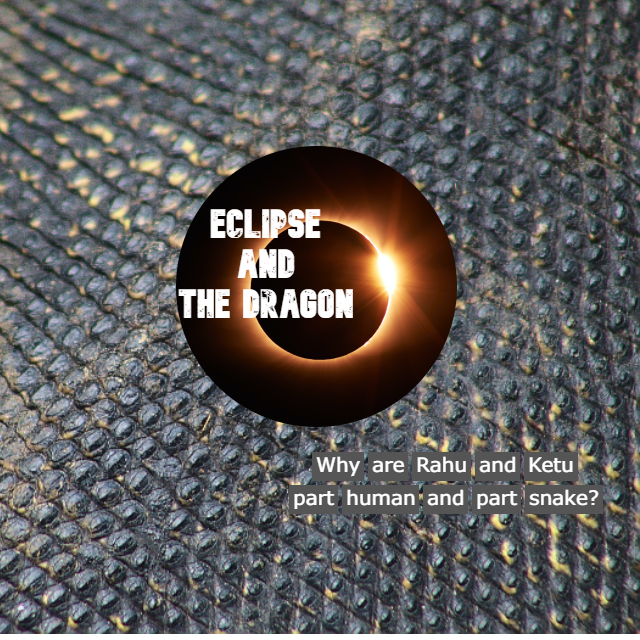How can a shadow be a planet? Can shadow qualify to be an object? What is the logic behind the part snake, part human representations of Rahu (Earth’s shadow) and Ketu (Moon’s shadow)?
The Sanskrit word Graha is very unique. Its English equivalent, namely planet, is however inadequate. Graha is a reference to a holder of an energy of some sort. However, the word planet does not convey this idea. European translators, two centuries ago, made the hurried assumption that the word Graha means Planet. The widespread use of the word planet to refer to Graha today creates confusion. A good example of this confusion is the literal translation of the phrase “Chaya Graha” to a shadow planet.
An overview of the related Sanskrit words gives us a better idea about the phrase Chaya Graha. Something that grasps, holds or seizes is Graha. According to Sri Sri Ravishankar, an expert on the terminology in Vedic texts, the entire universe constantly moves, fast. In this context, whatever has the ability to hold any part of the universal energy qualifies to be a Graha (QNA Nov 2015). According to this, a planet is a Graha. For example, Saturn grasps and redirects an inertial type of universal energy while Jupiter an uplifting kind of energy. Secondly, the Sun and the Moon also qualify to be a Graha. Certainly, the renowned set of Nine (Nava) Grahas includes the Sun and the Moon. Thirdly, the Nava-Graha set includes two Chaya Grahas.
Different Kinds of Grahas
The Samba Purana distinguishes the Sun and the Moon as Mandala-Graha. These Grahas have an aura field or a Mandala. Rahu and Ketu are Chaya-Grahas, because they act through shadows or Chaya. The remaining Grahas are Tara-Graha, because they, namely, the planets, appear like stars or Tara. Further, Samba Purana clarifies how the shadow of Earth is essential for Rahu to consume his quota of the Amrita nectar from the moon.

Further, the Purana clarifies that Rahu does not cause any physical defect, even momentarily, to the Moon during an eclipse. Rahu makes use of the shadow of the Earth to consume the Amrita which is present in Soma (Moon). The following verse explains this with the analogy of the Bee. A Bee sucks in the nectar from a flower without causing any physical defect to the latter. Similarly, Rahu usurps the Soma nectar which is meant for other Devas during an eclipse.

A side by step look at Vedic and modern astronomy vocabulary can lead to a logical question. Are Chaya Grahas a reference to the moon’s north and south nodes. The concept of Moon’s north node and south node allows astronomers to predict eclipses. However, is Rahu the north node? and Ketu the South node? Let us analyze the imagery associated with Rahu and Ketu.
Rich imagery of Rahu and Ketu
Rahu is half bodied per Vedic metaphor but so is Ketu. The lower half of Rahu’s body is depicted as the snake’s tail (Earth shadow). In addition, the upper part of a Snake becomes Ketu’s head (Moon shadow). Secondly, the human half of Rahu and Ketu are their tangible portions. Astronomy textbooks teach us about the important roles of shadows in the creation of an Eclipse. The snake half representation of the two Chaya Grahas suggests a shadowy nature. Besides, the two shadow representations complement each other. The shadow of one reaches a million Kilometers, like the tail of a snake. The other is short like the face section of a snake.
The Samba Purana does not explain the difference between Rahu and Ketu. It only attributes eclipse to the alignment of Rahu, Sun and Moon in the context of the shadow. Secondly, it clarifies that this shadow to be पार्थिवी in nature. This adjective can refer either to a shadow falling on the Earth or a shadow originating from the Earth.

The Sanskrit words for restraining (नि-ग्रह ni-grah), releasing (वि-ग्रह vi-grah), enveloping (परि-ग्रह pari-grah) and not letting go (आ-ग्रह aa-grah ) have the same root as Graha. These suggest the word “Graha” maybe a receptacle or the source of influence.

I could be wrong, of course, but I think that in the days when shadow planets were thought to exist (I don’t know what time that was) it was not known exactly how a solar and lunar eclipse came about. Since both a solar eclipse and a lunar eclipse clearly show a round shadow, I think at the time it was assumed that during an eclipse a planet X moved between the Earth and the sun (from Earth the sun is then eclipsed) and that during a lunar eclipse another planet Y moved between the sun and the moon (the moon is then eclipsed relative to the earth). Furthermore, it was thought that those planets were not visible, but they really existed. So it was not realized that the planet X was in fact the moon and the planet Y the earth. But again, because people didn’t realize that, the idea of the planets Rahu (earth shadow) and Ketu (moon shadow) came up.
My question is what time was that?
Thank you for the comment/question. The text Surya Siddhanta clarifies the fact about the shadows of the moon and the earth. This book was quoted by the Indian astronomer Aryabhata (500 CE). Modern historians date the Surya Siddhanta to the beginning of the common era.
The luminaries are called Graha in the Sanskrit language. Vedic texts (which historians date to 1500 BCE) refer to five planets in the solar system as Grahas. These texts include the phrase “Chhaya Graha”. Chhaya is a shadow. The knowledge of the impact of shadows may be 3500 years old.